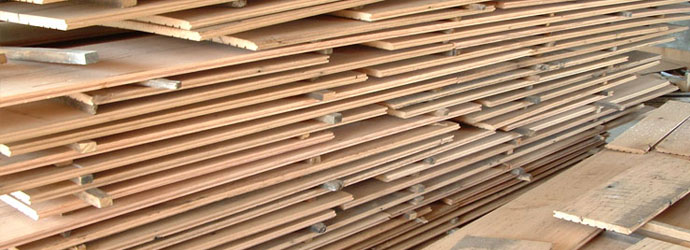
How to Acclimate Wood Flooring
We're planning to install hardwood floors, but we've heard hardwood floors need time to acclimate before installation. How long does hardwood need to acclimate? Also, if we decide to buy engineered floors, do we still need to wait before installing them? How long does engineered flooring acclimation take? Thanks!
~Chrissy and Todd G., Dallas, Tx.
Great questions! Before installing wood floors, the flooring needs to reach a moisture content (MC) level that is in equilibrium with the surrounding environment. This process is known as hardwood acclimation. Failing to properly acclimate wood flooring may cause excessive expansion, shrinkage, dimensional distortion or structural damage.
Ideal Temperature & Humidity for Wood Floors
Just like humans, wood is most comfortable within an ideal range of temperatures and relative humidity. In general, relative humidity in the building should be between 30-50 percent year-round for optimal wood flooring performance. Temperatures should be kept between 60° and 80° Fahrenheit. There are geographic exceptions to these guidelines, so be sure to ask your flooring professional and check the product specifications.
How to Store Wood Flooring at a Job Site
Wood flooring should not be stored at the job site under uncontrolled environmental conditions. Make sure wood is stored in an enclosed building. Garages and exterior patios are not acceptable areas to store wood flooring.
Verify the temperature and humidity in the building are maintained at normal living conditions. The best conditions for storing wood flooring will vary from region to region; ask your flooring installation professional about the ideal climate conditions for your floors.
Measure the Moisture Content of Wood Flooring
Immediately upon delivery, check the moisture content of your wood flooring with a moisture meter. This measurement will establish a baseline for acclimation. To ensure a more accurate measurement, check the moisture content of multiple boards – typically 40 boards for every 1,000 square feet of flooring.
Next, you’ll need to calculate the optimal moisture content. To begin, determine the expected seasonal change of wood moisture content for your location. Divide the high season and low season moisture content.
Acclimation may not be required if wood flooring is delivered and recorded at the baseline moisture content for your geographical location and if proper relative humidity conditions are maintained. On the other hand, if the moisture content of the wood is well outside of the optimal moisture content range, it may be very difficult to acclimate the product properly. In these circumstances, excessive shrinkage, bowing, and cupping of the wood may occur.
Before Installation: Operate Heat and/or Air Conditioning Systems
Permanent heating and/or air conditioning systems should be operating at least five days before you install your wood floors. This will allow the wood to acclimate to actual living conditions inside the building. Heating and A/C systems should continue to operate at normal conditions during and after installation.
If it is not possible to operate the permanent heating and/or air conditioning system before, during and after installation, a temporary heating and/or dehumidification system can be used to allow the installation to proceed.
Reaching Equilibrium Moisture Content
Prior to installation, wood flooring should be within acceptable range of moisture content with the wood subfloor.
- Solid strip flooring (less than 3" wide) should have a moisture content no more than 4 percent different from the moisture content of your subflooring materials
- Wide plank solid flooring (3" or wider) should have no more than 2 percent variance in moisture content compared to subfloor materials.
When wood is neither gaining nor losing moisture, equilibrium moisture content (EMC) has been reached. The chart below indicates the equilibrium moisture content of wood flooring at various temperatures and humidity conditions. Most flooring manufacturers use a 6-to-9 percent range for equilibrium moisture content – any higher or lower and wood flooring can shrink or swell dramatically.
Best Practices for Acclimating Wood Flooring
If the manufacturer recommends the wood flooring be acclimated before installation, proceed as follows:
Tip #1: Allow Wood Flooring to Acclimate for At Least Three Days
Acclimation times vary by species and product, but a rule of thumb is to acclimate wood floor products for at least three days. You’re trying to reach an equilibrium between the moisture content of the wood materials and the air where the product is being installed.
Acclimation is the process of reaching this equilibrium moisture content – that is, the point at which the wood is neither gaining nor losing moisture.
Tip #2: Break Flooring Materials into Smaller Lots
Professional wood flooring installers recommend opening your flooring packages and breaking the shipment into smaller lots. This will increase exposure to airflow, which helps with acclimation. You may also wish to cross-stack planks using spacers between layers to increase circulation.
Tip #3: Site-Finished and Engineered Flooring Requires More Time to Acclimate
If you’re finishing wood floors on-site, you’ll need to plan more time for the flooring to acclimatize – as much as 5-7 days. Engineered floors are often installed using adhesives that have volatile organic compounds (VOCs) that need to be evaporate prior to finishing. Be sure to look for recommendations from the adhesive manufacturer.
Tip #4: Treat Tropical Wood Species with Care
Some tropical wood species lose moisture or gain moisture at faster or slower rates than domestic species. In addition, the resins and oils in tropical woods can make accurate moisture content readings difficult. As a result, tropical wood species typically require more time to acclimate.
Tip #5: Follow Manufacturer Recommendations to Keep Flooring Warranties Intact
Some hardwood products may not require acclimation. In fact, your wood floors may have a warranty that could be voided if installation does not follow manufacturer recommendations.
How to Acclimate Engineered Wood Flooring
The process for engineered hardwood acclimation is similar to acclimating solid hardwoods. The major difference with engineered floors is that they may require more time after installation to acclimate before applying a finish due to the use of adhesives that may require time to let off gases.